#avian flu
Text

110 notes
·
View notes
Text



"If a pig catches both a human influenza A virus and an avian influenza A virus at the same time, it can spark a process known as viral reassortment — a genetic exchange in which flu viruses swap gene segments."
"Those swaps can introduce dramatic changes, producing a new virus with certain properties of a non-human strain coupled with the capacity to infect and spread between people."
"The death rate in humans may be upwards of 50 per cent, World Health Organization data suggests, though it's possible that milder infections are getting missed, skewing the case fatality ratio. Still, in a population that's never been exposed, the global impacts could be dire."
"More human cases could also be happening under the radar among farm workers who've moved to the U.S. from abroad, don't speak English as their first language, and may be hesitant to seek medical help, he added."
"So I think there's probably underreporting on both sides," Armstrong said."
"If [H5N1] gets into a population where there's constantly animals going in and out … it might not ever leave."
I've been watching this develop for the past several days, and apart from being terrified most people will not take this seriously (I've seen a handful of people already shout conspiracy on social media and it's alarming to see, as always). What I wanted to point out is that pandemics are going to continue to be our 'normal.' I watched a great video on YouTube a while ago (I believe it was by Vice?) that touched base on how this is going to become our new reality because of multiple factors (such as our proximity to animals, and environments/etc). It was when Covid hit and they did a piece debunking some of the misinformation floating on the internet. If I can find it I will post it here because it was informative and relevant to pretty much any world crisis we will see around any virus that spreads among a human population.
This post isn't trying to fear monger anyone, I just hope more people are aware of what is happening because this is important to talk about. There are already cases (of cows getting this bird flu) in the US, and I won't be surprised if there will be instances in more countries around the world. As usual, keep washing your hands/keeping good hygiene practices, masking up (and if you aren't I hope you consider it), and taking precautions if you do happen to visit/work or go near a pig or poultry farm too:
I'll keep track of this here of course, but please stay informed folks. And also FU to any governments who will try to minimize this or try to diminish the severity until it's too late and community spread happens like Covid because their actions are influenced by capitalistic interests.
Update (April 7th, 2024, 9:32pm EST): to anyone wondering where some of the source information originates from -here is a link to the CDC. They are tracking documented avian virus outbreaks in the US and the public can access it here:
#current news#current events#global news#united states#cattle#cows#cattle farming#avian flu#bird flu#h5n1#mask up#pandemic#covid#covid isn't over#covid conscious#covid is airborne#covid is not over#viruses#fuck capitalism#anti captialism#healthcare#public health#world health organization#cdc#news update#update
15K notes
·
View notes
Text
Emmanuel the Emu: A Story of HPAI Mismanagement
Emmanuel, the TikTok-famous emu owned by Taylor Blake of Knuckle Bump Farms, made national news last month when Highly Pathogenic Avian Influenza (HPAI) hit the farm. According to Blake’s initial Twitter thread, Knuckle Bump Farms lost 99% of their avian flock- over 50 individuals- in only three days. These deaths were attributed both to the disease itself and to a cull carried out by the Florida Department of Agriculture and Consumer Services, who did so with Blake’s permission. Emmanuel and a black swan named Rico were the only two survivors, with Emmanuel left unable to stand, unwilling to eat or drink, and quickly fading. Hundreds of thousands rallied behind Emmanuel on social media as Blake documented Emmanuel’s progress, reaching out to public figures like Dr. Pol of The Incredible Dr. Pol and Bindi Erwin of Crikey! It’s the Irwins for help when she failed to find any other sources for emu rehabilitation. But soon, controversy emerged.
Early on, avian influenza experts expressed concern that Blake was not wearing any PPE when interacting with a presumably HPAI-positive bird. Avian influenza is transmissible from bird to human which, combined with the virus’ ability to mix genes and rapidly change, means that PPE is universally recommended when dealing with a suspected or confirmed HPAI outbreak.

In response to concerns, Blake explained that “Emmanuel freaks out whenever we approach him wearing a mask” and that the farm is on a state-mandated quarantine for 150 days, which is the amount of time HPAI is estimated to survive in the environment under ideal conditions. This quarantine reportedly only allowed Blake, Blake’s girlfriend Kristian Haggerty, Blake’s family, and veterinary professionals to enter the property. “I have taken every precaution recommended by the FDA” Blake stated, referencing the Florida Department of Agriculture and Consumer Services (FDACS) rather than the Food and Drug Administration (FDA).
Many people, including HPAI experts, found this explanation unsatisfactory and instead decided to contact the FDACS and USDA directly. Both the FDACS and USDA work collaboratively to manage avian influenza outbreaks in Florida. Dr. Danielle Stanek of the Florida Department of Health clarified that the DOH can recommend that private individuals comply with CDC guidelines, which includes wearing full PPE when interacting with HPAI-infected birds, but they cannot mandate that they do so. Therefore, Blake’s decision to forgo PPE was hers to make, even if it wasn’t in accordance with the recommendations of the FDACS, CDC, USDA, and Florida DOH.
Just as discourse between experts and Emmanuel fans reached its peak, Blake announced that Emmanuel tested negative for HPAI. Instead, Emmanuel’s sudden decline was attributed to stress. “Emus are incredibly susceptible to stress. He was incredibly overwhelmed by the state coming in and euthanizing our flock . . . He stopped eating the day they depopulated.” His lingering issues- the inability to stand or walk independently, twisted neck (torticollis), continued inappetence and dehydration, and lethargy- were caused by a nighttime collapse that left Emmanuel “thrashing on the ground for hours, trying to get himself up”. “He never once had a single symptom of AI, other than not eating”, Blake stated.
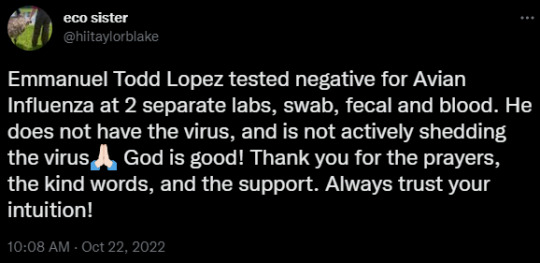
HPAI symptoms in birds varies depending on the species and the individual. In chickens, HPAI often presents as respiratory and digestive distress, followed quickly by death. In other poultry species, symptoms may also include the nervous system, causing “tremors, twisted necks, paralyzed wings, laying down and pedaling”. Ratites- referring to the diverse group of keel-less birds that include emus, ostriches, rheas, kiwis, and cassowaries- also tend to develop neurological symptoms. Notably, emus can present with twisted necks (torticollis), ataxia (discoordination), leg and wing paralysis, inability to stand, decreased food and water consumption, purple discoloration or swelling of the legs and head, and lethargy. This corresponds with many of the symptoms Blake has documented in Emmanuel. And it should, considering that Emmanuel did test positive for HPAI.
Test results completed on October 27th, 2022 at the USDA’s National Veterinary Services Laboratories showed that Emmanuel’s serum sample, collected six days after the start of the outbreak, contained antibody levels that were consistent with recent infection.
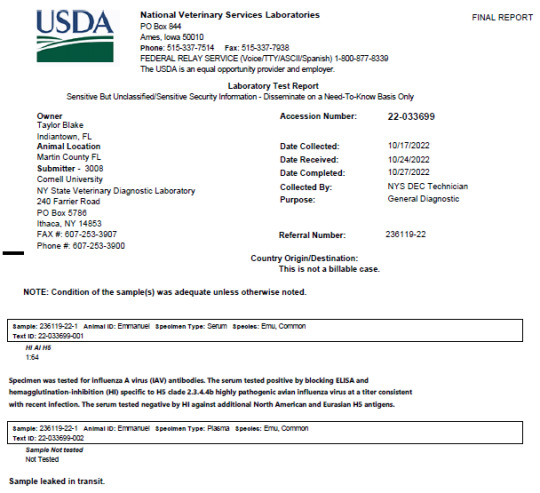
When Blake announced Emmanuel’s stress diagnosis, she was likely relying on information provided by a rapid test, which can provide results within 48 hours. These tests detect viral proteins that indicate active infection and virus shedding. Serology tests, on the other hand, look for the presence of antibodies produced in response to infection, not necessarily active infection. For an indeterminate number of days prior to the sample collection (October 17, 2022) Emmanuel had an active HPAI infection that, rather than stress, likely led to his rapid decline.
Why, then, was Emmanuel not included in the state’s cull on Knuckle Bump Farms? An email between Dr. Michael Short, the FDACS’ Animal Industry Director, and Kassandra Curiel of the FDACS’ Office of the Commissioner, answers this question. Dr. Short states that “USDA guidance is that ratites (emus and ostriches), black swans and exotic pet birds do not have to be euthanized due to lower risk”. Blake echoes this on her Twitter, when she says that “the state only focused on the “super spreaders” which are poultry species and ducks. Ratites aren’t included because they typically aren’t as susceptible.”.
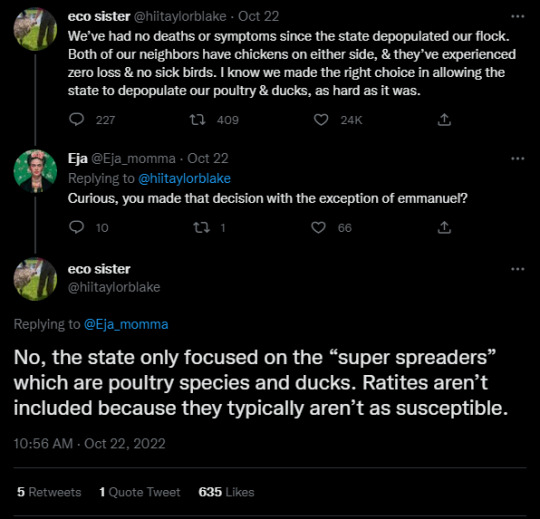
This allowed Knuckle Bump Farms’ four emus (Emily, Eliza, Elliot, and Emmanuel) and three black swans (two unnamed females and Rico), to be exempted from the cull. I cannot find any reference, either in USDA literature or anywhere else, that supports Dr. Short’s statement. In fact, all the literature that I reviewed and all the experts I talked to during my research only confirmed the devastating effects that HPAI can have on both ratites and black swans. This, coupled with the fact that three of Knuckle Bump Farms’ four emus and two of their three black swans died when “the virus hit them extremely hard and very quickly”, calls Dr. Short’s statement into question.
The USDA was also unable to substantiate Dr. Short’s statement. When asked how exemptions to culls were determined they explained that, rather than look at individual species, the USDA classifies HPAI-infected domestic birds as either commercial, backyard poultry, or backyard non-poultry. These definitions ascribe risk of potential HPAI spread by determining the level of contact a poultry premise has with other poultry premises. If a private farm or private household, where the poultry does not have any contact with poultry beyond the property, has an outbreak then they are classified as a non-poultry premises, even if they have chickens, turkeys, or other poultry birds. These non-poultry premises can thus be exempted from culling all their birds by being placed on quarantines by state officials, provided that they adhere to the quarantine and continue to not have contact with any poultry facilities. Knuckle Bump Farms does not sell poultry products; therefore, they were classified as backyard non-poultry and eligible for quarantine. The FDACS seems to have added their own interpretation onto this guidance when they specify ratites, black swans, and exotic pet birds as “lower risk”. I reached out to Dr. Short for comment but received no response.
This isn’t the only time Dr. Short and, by extension, the FDACS demonstrated faulty logic. In that same email between him and Curiel, Dr. Short used this comparison to explain why a citizen’s concern about Emmanuel’s exemption from the cull was unfounded.
“I have heard of only one report of a clinically ill human, over the past 1.5 years of a national response to the current avian flu outbreak. The risk of HPAI to the owner is much less than occurred with household pets that tested positive for SARS-CoV-2 (Covid). I am assuming no one would advocate to euthanize all pets testing positive for Covid (At least I have not heard of anyone asking us to euthanize pets).
The risk of avian influenza is constantly occurring with all the wild birds in South Florida. My understanding (not being a human health expert) is the risk to people, especially children and those immuno-compromised at public or private lakes, ponds and waterways from the AI being shed by water fowl is much greater than the sick emu at knuckle bump farm.”
Dr. Ben Golas, a VMD and postdoc with the USGS who is currently working on avian influenza research, weighed in. “It’s a bit like comparing apples and oranges to talk about risk of transmission of COVID vs. HPAI. With COVID, our primary concern is human-to-human contact. [. . .] With HPAI, farm animals are euthanized not only because the disease spreads within the farm flock like wildfire, but also to prevent spreading infection locally to other farms, because HPAI virus can be stable in the environment.”
The CDC agrees. “There is no evidence that animals play a significant role in spreading SARS-CoV-2, the virus that causes COVID-19, to people. […] It’s important to remember that people are much more likely to get COVID-19 from other people than from animals. There is no need to euthanize or otherwise harm animals infected with SARS-CoV-2.” When it comes to HPAI, however, they emphasize that human-to-human spread is rare and often limited to only a few individuals. Bird-to-human transmission is the primary method of human infection, with each new infection increasing the risk that a new, more virulent strain will emerge. This, along with the potential for massive bird-to-bird outbreaks that could devastate both wildlife and industry, is why complete depopulation (euthanasia) is standard for HPAI and not COVID-19.
The FDACS seems to be operating on contradicting and unsubstantiated information when it comes to managing HPAI outbreaks. Unsurprisingly, the employees seem equally conflicted in their internal emails regarding Knuckle Bump Farms. One Florida USDA representative noted, while forwarding a citizen concern about Blake’s lack of PPE, that “her face is real close to a bird that has HPAI”. Another USDA employee responded “actually, in one of the pictures she appears to be kissing it on the head.”. Dr. Kendra Stauffer of the USDA wrote, “. . . part of the allowing the pet bird to live was that there were rules the owner was to follow from DOH, which clearly she is not”.
Other employees, however, were eager to show their support. Commissioner Nikki Fried of the FDACS posted a photo of her, Blake, and Haggerty, and later posted a photo of herself drinking Knuckle Bump Farms’ branded beer while wearing an Emmanuel t-shirt.
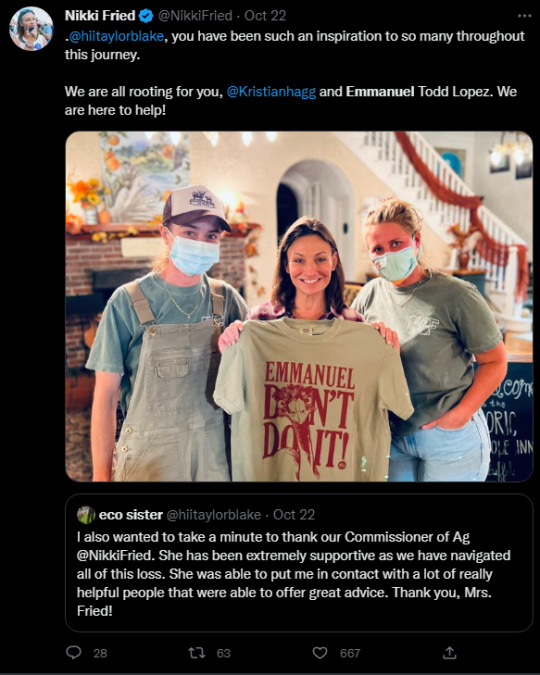
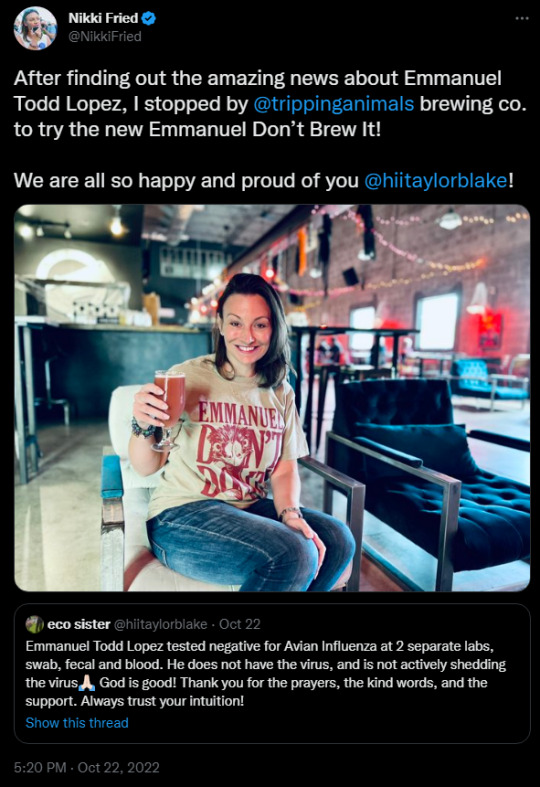
Fried’s support generated a lot of concern, particularly amongst local farmers. One Florida emu farmer stated, “my disappointment and concern is 100% with the actions of Nikki Fried as Agricultural Commissioner to allow some birds to be exempt from depopulation, including emus, for no quantifiable reason. Emus are susceptible to HPAI. Emus in other states have contracted HPAI in this current outbreak and they either died on their own or were put down. Research shows they are susceptible to HPAI, and can spread it to other birds and humans. The decision by Fried and FDACS makes no sense and it sets a dangerous precedent.”
Considering that Blake has over 847.4K followers on Twitter, 938K on Instagram, and 2.4 million on TikTok, the precedent the FDACS and USDA have set here is, indeed, dangerous. Many of Blake’s followers learned about avian influenza for the first time through her documentation of Emmanuel’s illness and the state’s response to the outbreak. “I watch for Emmanuel updates every day! This has also been a great lesson for many people in farming education.”, one follower said. Another echoed this sentiment, saying “Thank you for taking the time to let us know what’s going on, and answering questions. You truly are an educator”.
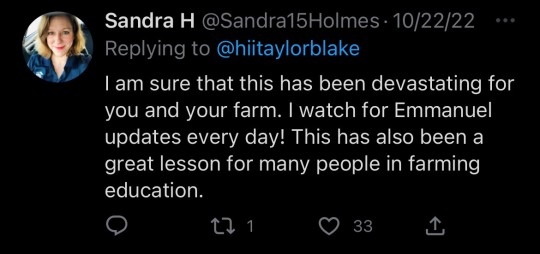

Herein lies the problem. Knuckle Bump Farms is a small, backyard operation. Through social media, however, they reach millions. This specific outbreak of HPAI and its subsequent (mis-)management by the FDACS and USDA has now set the standard for many, rather than the exception. Blake’s public failure to comply with PPE recommendations, the lack of transparency regarding Emmanuel’s true diagnosis, a similar lack of transparency within the FDACS and USDA regarding this outbreak, exemptions to cull protocols made with seemingly no supporting data, and a publicly-elected official openly (and financially) supporting Blake through this process, all pose a serious threat to public confidence in HPAI management and future public health. The concerns of farmers, virologists, public health workers and organizations, wildlife rehabilitators, and animal sanctuaries have been ignored, particularly when they asked whether Emmanuel’s fame and the risk of public backlash led to the FDACS’ decision to leave him and several other symptomatic birds alive. It seems, through this research, that there is more support for this theory than the narrative we’ve been provided until now. It is my hope that, with the publishing of this information, the very real concerns raised by people directly effected by HPAI will be given the weight they deserve.
Please take this opportunity to learn about avian influenza from reputable sources:
Protecting Birds from Avian Influenza
Avian influenza and PPE
CDC Avian Influenza
USDA HPAI Response Plan
Florida Avian Influenza Update (Oct 2022)
A huge thank you to the following experts who generously answered my questions: Dr. Ben Golas, Dr. Jim Wellehan, and Dr. Jennifer Riley.
2K notes
·
View notes
Text
⚠️🚨⚠️ WARNING ⚠️🚨⚠️
Jason Shurka reveals the next plandemic. 🤔
#pay attention#educate yourself#educate yourselves#knowledge is power#reeducate yourself#reeducate yourselves#think for yourself#think for yourselves#think about it#do your homework#do some research#do your own research#do your research#question everything#ask yourself questions#plandemic#avian flu#be prepared#be ready
424 notes
·
View notes
Text
Authorities: Dairy cows catching bird flu is nothing to worry about. People won’t catch it.
One week later…

[ID: This is fine meme - A dog wearing a hat is sitting at a table with a cup of coffee. The entire room is on fire. The dog says “This is fine.”]
75 notes
·
View notes
Text
California agencies working to protect critically endangered condors are on high alert after 20 recent deaths in northern Arizona, wildlife officials said last week.
A highly pathogenic avian influenza that has infected domestic and wild birds across the country has been confirmed as the cause of death for California condors in in the Arizona-Utah flock. By April 17, the U.S. Fish and Wildlife Service reported 20 condors had died. So far, tests confirmed 10 of those birds were positive for the avian flu.
The virus had not been detected in condor populations in Ventura County or other parts of California and Baja as of late this week. But agencies monitoring those flocks were preparing emergency actions in case that changes, said Ashleigh Blackford, the federal agency’s California condor coordinator.
“Our concern is definitely heightened in California,” Blackford said.
More populations, more protection
Agencies have worked for decades to help the species recover. The largest flying land bird in North America — known for its bald head and black feathers — had all but disappeared in the wild by the early 1980s.
The population dropped to just 22 birds in the wild in 1982. Five years later, all remaining wild condors were placed in a captive breeding program to save the species from extinction.
By the end of last year, 347 condors lived in the wild – 183 in California and 116 in the Arizona-Utah region.
Supporting separate populations in different areas was part of the plan to help the species overcome any single event such as a virus outbreak or wildfire. The more populations and the more birds increases the odds of survival, Blackford said.
The condors also continue to rely on captive-bred birds being released into the wild.
Virus can be fatal
The avian influenza can spread quickly and appears to be almost 100% fatal for some species. But scientists didn’t know until the recent outbreak how infected condors would fare.
“Now, we know that answer, and it is an unfortunate answer," Blackford said.
But some condors do appear to be recovering. Eight sick condors were captured in Arizona and brought to a facility for treatment. Of those, four died and four others are still receiving care and showing signs of improvement, wildlife officials said.
A setback for Arizona flock
The 20 recent deaths account for around 17% of the Arizona-Utah flock. That's four times the number of deaths in the region last year.
"That’s a substantial setback for this flock," Blackford said. "But it is not insurmountable."
In all of last year, the agency reported 20 condor deaths, most of them in California. Lead poisoning is consistently the leading the cause of death and continues to be the biggest concern for agencies working to protect the species.
The birds feed on carcasses containing bullet fragments, so trying to get folks to use other types of ammunition continues to be a priority, wildlife officials said. Lead poisoning not only can be fatal but also can suppress the immune system, increasing the condors risk from other illnesses.
"If we were not losing birds to lead, then our population would be stronger," Blackford said. "It would be more robust, and we would have healthier birds."
How to help
While the risk to the public's health is low, officials said human infections can happen and the general public should avoid handling wild birds. State and federal agencies recommended the following tips.
Report dead birds using the state's mortality reporting system to help officials monitor the outbreak at wildlife.ca.gov/Living-with-Wildlife.
If you see condors, observe from a distance. Stress can be harmful to birds exhibiting symptoms of illness.
Keep your family, including pets, a safe distance away from wildlife. Do not feed, handle or approach sick or dead animals or their droppings.
Prevent contact of domestic or captive birds with wild birds.
Find more information about the avian influenza: cdfa.ca.gov/ahfss/Animal_Health/Avian_Influenza.html, aphis.usda.gov/aphis/ourfocus/animalhealth/animal-disease-information.
#California condors#California condor#raptors#birds of prey#birds#animals#wildlife#nature#vultures#avian flu#endangered species#extinction#animal death
294 notes
·
View notes
Text

It's the Bird Flu!
We're all doomed.. again!
#lego#brickcentral#afol#lego photography#toy photography#bird flu#avian flu#H5N1#Seagulls#death from above
143 notes
·
View notes
Text
H5N1: What to know before fear spreads
What is H5N1?
H5N1 is a 1996 strain of the Spanish or Avian Flu first detected in Chinese birds before spreading globally across various avian species. H5N1 is similar to H1N1, but spreads slower and has a much higher mortality rate.
H5N1 may also be referred to as Influenza A. The American Association of Bovine Practitioners has seen fit to rename H5N1 to Bovine Influenza A Virus, or BIAV, and are encouraging others to use the same terminology.
I would not be surprised if the colloquial name among the public becomes Bovine Flu or American Flu in the coming months, and may be referred to as the Chinese Flu by the same folks who took the spark of the SARS-CoV-2 (COVID-19) pandemic as an excuse to be publicly racist to East Asian people without social repercussions.
BIAV is a virus, meaning that it is a (probably) non-living packet of self-replicating infectious material with a high rate of mutation. BIAV is structured similarly to SARS-CoV-2, having a packet of infectious material encased in a spherical shell with a corona, or crown, of proteins that can latch to living cells to inject RNA.
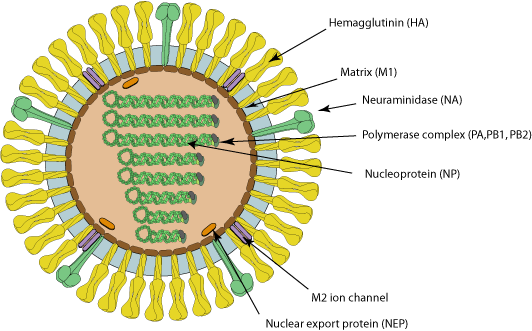
Image source with interactive model: ViralZone - H5N1 subtype
What is the history of BIAV?
In 1996 and 1997, an outbreak of BIAV occurred among poultry and infected 18 people in Hong Kong, 6 of which died. This seemingly isolated incident then infected ~860 people with a >50% death rate.
At the time, BIAV was known as Highly Pathogenic Avian Influenza, or HPAI, and killed nearly 100% of chickens within a 48 hour period.
From 2003 to 2005, continual outbreaks occurred in China and other East Asian countries, before spreading to Cambodia, the Netherlands, Thailand, and Vietnam.
From 2014 to 2016, it began being detected in American fowl, as well as mutating the H5N6 (lethal in birds, no human to human transmission) and H5N8 (largely spread through turkeys, ducks had immunity) viruses.
BIAV has since evolved into a clade known as 2.3.4.4b, and was first detected in 2021 in wild American birds. This then caused outbreaks in 2022 among wild and domesticated birds (such as chickens) alike, but was largely being overshadowed by the pressing SARS-CoV-2 pandemic at the time.
From 2022 to 2023, it was observed to be spreading among various mammals, including humans. Now, in 2024, we're having the most concerning rapid outbreak of BIAV since 2003.
BIAV is known to spread from mammal to mammal, particularly between cows and humans. BIAV may also be spread from cow to cow (highly likely, but not confirmed - this is likely the reason the virus has spread to Idaho from Texan cattle), and is known to be lethal to domestic cats and birds within 48 hours.
How does BIAV spread?
BIAV spreads through fomites - direct contact with infected animals or infected surfaces and then touching parts of your face or other orifices - as well as through airborne particulates, which may be inhaled and enter the sinuses and lungs.
BIAV is known to spread through:
Asymptomatic
Ducks, geese, swans, various shorebirds
Symptomatic, may be lethal
Foxes, bears, seals, sea lions, polar bears, domestic cats, dogs, minks, goats, cows, (potentially human to human, but unconfirmed - there have only been 8 potential human to human cases in 2024).
How can I protect against BIAV?
As BIAV is a type of Influenza A, existing protocols should do fine.
Current recommendations are to wash your hands vigorously after interacting with birds (I would also recommend doing this with mammals), avoid touching your face or other open orifices, and wear N95 masks.
Avoid sick or dead animals entirely - I would also recommend reporting them to your local Animal Control or veterinary centre and warning them about the infection risk. People who work with animals are recommended to also wear full PPE such as N95 masks, eye protection, gloves, and partake in vigorous hand washing.
If you suspect you've caught BIAV, seek medical attention immediately. Existing medications such as oseltamivir phosphate, zanamivir, peramivir, and baloxavir marboxil can reduce BIAV's ability to replicate.
Standard flu shots will not protect against BIAV. Remember - symptoms of BIAV may not manifest for between 2 to 8 days, and potentially infected people should be monitored for at least 10 days.
How far has BIAV spread?
BIAV is currently a global virus, though the current infection location of note is the United States.
Image Key:
Dark red - Countries with humans, poultry and wild birds killed by H5N1
Deep red - Countries with poultry or wild birds killed by H5N1 and has reported human cases of H5N1
Light red - Countries with poultry or wild birds killed by H5N1
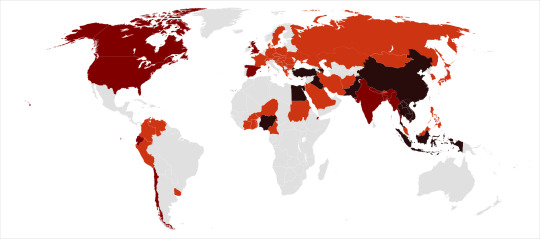
Image source: Wikipedia - Influenza A virus subtype H5N1 - File: Global spread of H5N1 map
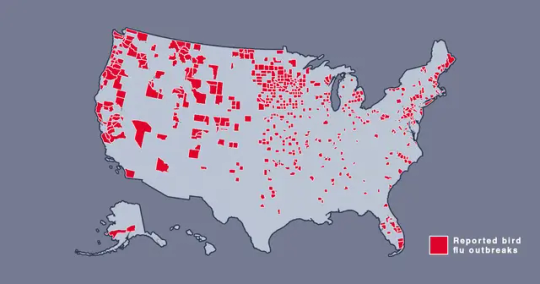
Image source: Metro.co.uk - Map shows where bird flu is spreading in US amid new warning - File: The Centers for Disease Control and Prevention’s H5N1 bird flu detections map across the United States
Should I be afraid?
You needn't be afraid, just prepared. BIAV has a concerningly high lethality, but this ironically culls its spread somewhat.
In the event human to human transmission of BIAV is confirmed, this will likely mainly affect marginalized communities, poor people, and homeless people, who are likely to have less access to medical care, and a higher likelihood of working in jobs that require frequent close human contact, such as fast food or retail jobs.
Given the response to SARS-CoV-2, corporations - and probably the government - may shove a proper response under the rug and refuse to participate in a full quarantine, which may leave people forced to go to work in dangerous conditions.
If this does spread into an epidemic or pandemic, given our extensive knowledge about Influenza, and the US having a backup vaccine for a prior strain of H5N1, a vaccine should be able to be developed relatively quickly and would hopefully be deployed freely without charge - we won't have to worry about a situation like The Stand.
Wash your hands, keep clean, avoid large social gatherings where possible, wear an N95 mask if you can afford them (Remember: Cloth masks are the least protective, but are better than nothing. If you can't afford N95 masks, I recommend wearing a well-fitted cloth mask with a disposable face mask over it to prevent pneumonia from moisture buildup in the disposable mask), support the disabled, poor, and homeless, and stay educated.
We can do better this time.
Further things to check out:
YouTube: MedCram - H5N1 Cattle Outbreak: Background and Currently Known Facts (ft. Roger Seheult, M.D.)
Wikipedia - Influenza A virus subtype H5N1
Maine.gov - Avian Influenza and People
CDC.gov - Technical Report: Highly Pathogenic Avian Influenza A(H5N1) Viruses
Wikipedia - H5N1 genetic structure
realagriculture - Influenza infection in cattle gets new name: Bovine Influenza A Virus (BIAV)
#H5N1#bird flu#avian flu#bovine flu#BIAV#pandemic#epidemic#COVID 19#coronavirus#spanish flu#long post#text post#no id#undescribed#news#politics#us news#us politics#american news#american politics#world news#global news#global politics#world politics#lgbt#lgbtq#queer#trans#communist#socialist
29 notes
·
View notes
Text
Experts have been warning for years that factory farms are an ideal incubator for disease and make mutations far more likely - if we carry on farming animals as we are now (which we have to in order to meet anything even close to current levels of demand), the next zoonotic pandemic is a matter of when, not if.
145 notes
·
View notes
Text
Maybe it’s just my feed but the only place I’m seeing anything about h5n1 is twitter. PAY ATTENTION TO IT!!! Prepare NOW! not when everyone starts to hear about it, not when everyone starts to care, not when the CDC finally admits it’s an issue (if they ever do). Prepare right now. While you have the chance. I am talking to everyone in my life about masks and precautions. I was hesitant about it before bc fear of confrontation but I’m cracking down now. I am going to stock up on essentials. My list right now is non-perishable foods, masks, bottled water, first aid kits, basic medications, and other essentials I can think of. I am going to be incredibly diligent about hygiene and selective about where I go in public. This is not me trying to fear monger. I would rather be paranoid and alive than dismissive and dead. This has high potential to be so so so serious. Please treat it as such.
#h5n1#bird flu#avian flu#disaster preparedness#quarantine prep#preparation#pandemic#public health#health#safety#social justice#disabled liberation#disability justice#cdc
10 notes
·
View notes
Text
"Scientists are demanding more evidence from officials to prove that milk is safe after pasteurization, when it is rapidly heated and then cooled to 'kill off' any viruses or bacteria.
Experts are particularly weary of assurances from public health bosses — as the FDA previously said the virus could not enter the milk supply due to pasteurization.
Dr Bright said: 'I've spent 27 years studying H5N1 viruses. So, I'm going to wait for data I hope is coming soon from both FDA (pasteurization) and USDA (genomic data and raw milk handling).'
He added: 'When H5N1 [the strain of bird flu] news broke, [I said] "They would have to do a lot of testing before I would drink milk from one of these farms at this point".
Commentary: Some small-scale testing has been done showing minimal random samples of H5N1 infected grocery store milk do not reproduce in vitro. However this does not cover all dairy products or pasteurization methods and comes on the tails of studies showing H5N1 surviving both high and freezing temps and gives us no information about how the virus will act in vivo.
61 notes
·
View notes
Text


Official statement:

#current events#current news#global news#cows#avian flu#bird flu#h5n1#pandemic#cdc#public health#healthcare#news update
172 notes
·
View notes
Text
Tl;dr an important Dutch bird sanctuary is in danger of closing due to rising costs associated with the avian flu 😱 If you have the resources to donate, link below, otherwise please help by spreading the word 🐤🪺
GoFundMe: https://gofund.me/6a6789c7
Details from a friend:
Vogelklas, one of the only remaining Dutch bird sanctuary in its area, is in danger of closing. They have tended to 11,000 birds in the past 12 months and they really need our help to keep their doors open right now. They are taking on more animals than ever since they are one of the only ones left, and there are many extra costs for them as they fight to protect their birds from the birdflu. Please 🙏 consider donating even just a little to this sanctuary so these animals stay safe and healthy, and conservation efforts in the Netherlands can continue. 💙🐦
60 notes
·
View notes
Text
It's Monday! Which means now is a good time to check if all your bird feeders/birdbaths/hummingbird feeders are empty and, if they are, wash them!
Here's a map of all reported cases of avian flu in America. If you live in an area with multiple cases reported in wild birds be sure to remove your feeders and baths. Most recent cases as of this post were reported May 12th!
378 notes
·
View notes
Text
The Weather
Similar to this time last year, COVID wastewater levels in many states have decreased and now remain at low levels except for the states of Tennessee and Missouri, which are at high levels. Arkansas, Alabama, Delaware, Minnesota, and Virginia have moderate viral levels detected by wastewater surveillance. This reminds us that it is important to continue the practice of precautions, especially among those most vulnerable to a COVID infection.
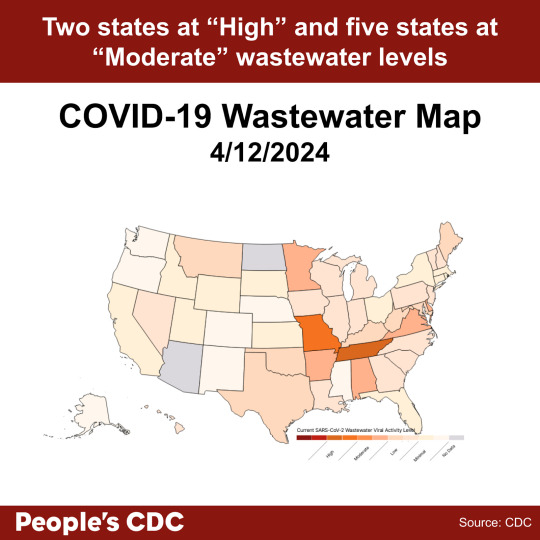
When considering trends in wastewater levels across all four regions, they have stopped decreasing as seen in the provisional data (gray shaded area). The national wastewater levels are indicated as “Low.” While lower wastewater levels indicate decreased spread, the risk for infection remains moderate especially as current wastewater levels remain slightly higher than previous low periods.

Wins
During the past few weeks, we have taken several actions against removing vital public health measures, especially the change in COVID isolation guidelines. This included the People’s CDC press conference from March 13, a recording and our press release are available. We also have a pre-proof of the People’s CDC External Review in the American Journal of Preventive Medicine Focus that additionally highlights the shortcomings of the CDC’s approach to public health and recommends a more equitable pandemic response. This week, we have assembled an expert letter asking the CDC to correct their COVID isolation guidelines.
Community groups continue to show us that it is possible to push back against corporate efforts to further privatize healthcare – and win. In Massachusetts, the Boston Center for Independent Living and SEIU 1199 led a successful drive to prevent cuts to publicly funded personal care attendants (PCAs) for disabled people. When we fight, we win.
Variants
Currently, JN.1 remains the dominant variant in the US, and is 83.7% of circulating variants as of 4/13/2024, down from 88.5% on 2/3/2024. JN.1.13 has increased to 9.1%, up from 0.7% on 2/3/2024. Other variants comprise 7.2% of the remaining total. A recent study, published in The Lancet Infectious Diseases, provided additional information on recent COVID variants that shed higher levels of wastewater; however, this cannot discount that COVID transmission remains at higher risk during rises in wastewater levels.
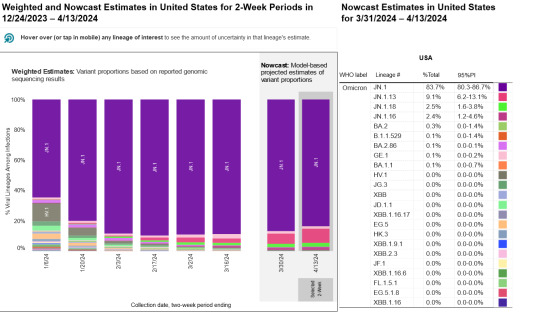
Hospitalizations
Total new hospital admissions caused by COVID have decreased to 7,318 during the week of April 6, 2024. Although the number of new hospital admissions are lower than the past, many counties in the US continue to experience increases in new hospital admissions. Over 25% of all counties are experiencing an increase in new COVID hospital admissions between the last week of March 2024 and the first week of April 2024. Most concerning, we still do not know the total number of hospital-acquired infections, since reporting over these numbers halted in May 2023. Despite this decrease in new hospital admissions and wastewater levels are currently at low levels nationwide, total hospitalizations do not completely reflect the current amount of circulating virus.


Prevention and Precautions
The CDC recently released guidelines to improve ventilation and implementation of air purification to prevent the spread of infectious diseases, specifically airborne pathogens. A group of scientists have also jointly published a policy statement in the academic journal Science supporting the establishment of higher standards for ventilation and the importance of air purification in indoor settings. Two studies published in the last month have validated the significance and value of both ventilation and air purification in schools and childcare centers to prevent the spread of COVID.
Vaccine uptake remains limited. Only 22.8% of adults and 14.1% of children have received the updated COVID vaccine as of 4/11/2024 - a slight increase from 21.1% of adults and 12.8% of children on 3/10/2024. The Bridge Program remains available for those underinsured or without insurance for no-cost access to these vaccines, but may end December 31, 2024.
Long COVID
Senator Bernie Sanders, as chair of the Senate Health, Education, Labor, and Pension Committee, proposed draft legislation to address Long COVID. This proposal aims to allocate $1 billion annually for a decade to the NIH for Long COVID research, establish a centralized research entity and advisory board, create a rapid grant process for clinical trials, develop a patient data database, and enhance public education on Long COVID. We ask that you share your thoughts to their official contact by email specifically on allocating funding for effective treatments and specific measures in the prevention of Long COVID by April 23, 2024. Currently, Long COVID Alliance has compiled a list of active opportunities in studies and clinical trials that people with Long COVID may participate in, which may help the clinical community contribute knowledge of Long COVID and potentially support the development of effective treatments.
Take Action
An invaluable home-based program that supports testing, evaluation, and treatment for COVID, Test to Treat program, is ending on April 16, 2024. Send a letter to your local representatives to ask them to help save the program that helps so many at-risk people!
It’s been over a month since the CDC released new, irresponsible guidelines on COVID isolation which are not substantiated by scientific evidence. Our fight to take public health out of the hands of corporate interests and protect our collective well-being continues. As part of our strategy to push back, we’ve put together an expert letter to CDC Director Mandy Cohen telling her to reinstate science-based COVID isolation guidelines. We urge the CDC to consider the highly variable length of infectiousness in their recommendations and to adopt a test-based approach for ending isolation. This letter is for public health professionals, scientists, healthcare workers, disability advocates, and others who consider themselves experts in public health. Sign this letter asking the CDC to correct their updated COVID isolation guidelines.
Avian Flu (Awareness Update)
The People’s CDC is monitoring Avian Influenza (AKA “Bird Flu”) as it has been spreading in many avian and mammalian species around the world at alarming rates. The current strain of concern is subtype H5N1 clade 2.3.4.4b and is highly pathogenic in poultry, causing systemic infections and rapid onset of illness and death among avian species (1). As such, this is called a highly pathogenic avian influenza (HPAI). This specific clade emerged in 2020 and has now been detected on every continent (2,3,4, 5). Over 500 species of birds and 360 species of other animals have been infected worldwide. Hundreds of thousands of wild animals have died from avian influenza since its emergence in 2020 (1, 6). Here in the U.S., at least 28 outbreaks have occurred in cattle farms (6, 7).
While human cases remain low, case fatality in humans has historically been around 50% (6). The outbreak among many non-bird animals is alarming and allows for opportunities for viral mutations that may lead to further infections among humans (1,6). The ecological consequences of such mass death around the world are currently unknown but guaranteed to be devastating as food webs are severely disrupted and conservation efforts suffer (1, 5). Humans are already feeling the direct impact of this as farmers are forced to cull entire flocks of poultry to control the spread, which may result in increased prices in the food supply (6). Humans will probably continue to feel the impacts of this historic spread, regardless of the number of human cases. We will continue to monitor the situation and share updates as the situation develops.
UC Davis
CDC
CDC
Viruses
Nature
Vox
BNO News
#op#covid19#covid-19#covid 19#pcdc#covid#people's cdc#cdc#coronavirus#pandemic#sars-cov-2#sars cov 2#covid news#long covid#covid pandemic#covid isn't over#covid conscious#covid is not over#avian flu#bird flu#h5n1#test to treat#uspol#covid prevention#covid levels#public health#coronavirus pandemic#links#img#described in alt text
12 notes
·
View notes
Text
So, avian flu has now been found in wild birds in a Manhatten park. CBS2 reported on it.
Be safe, everyone.
7 notes
·
View notes